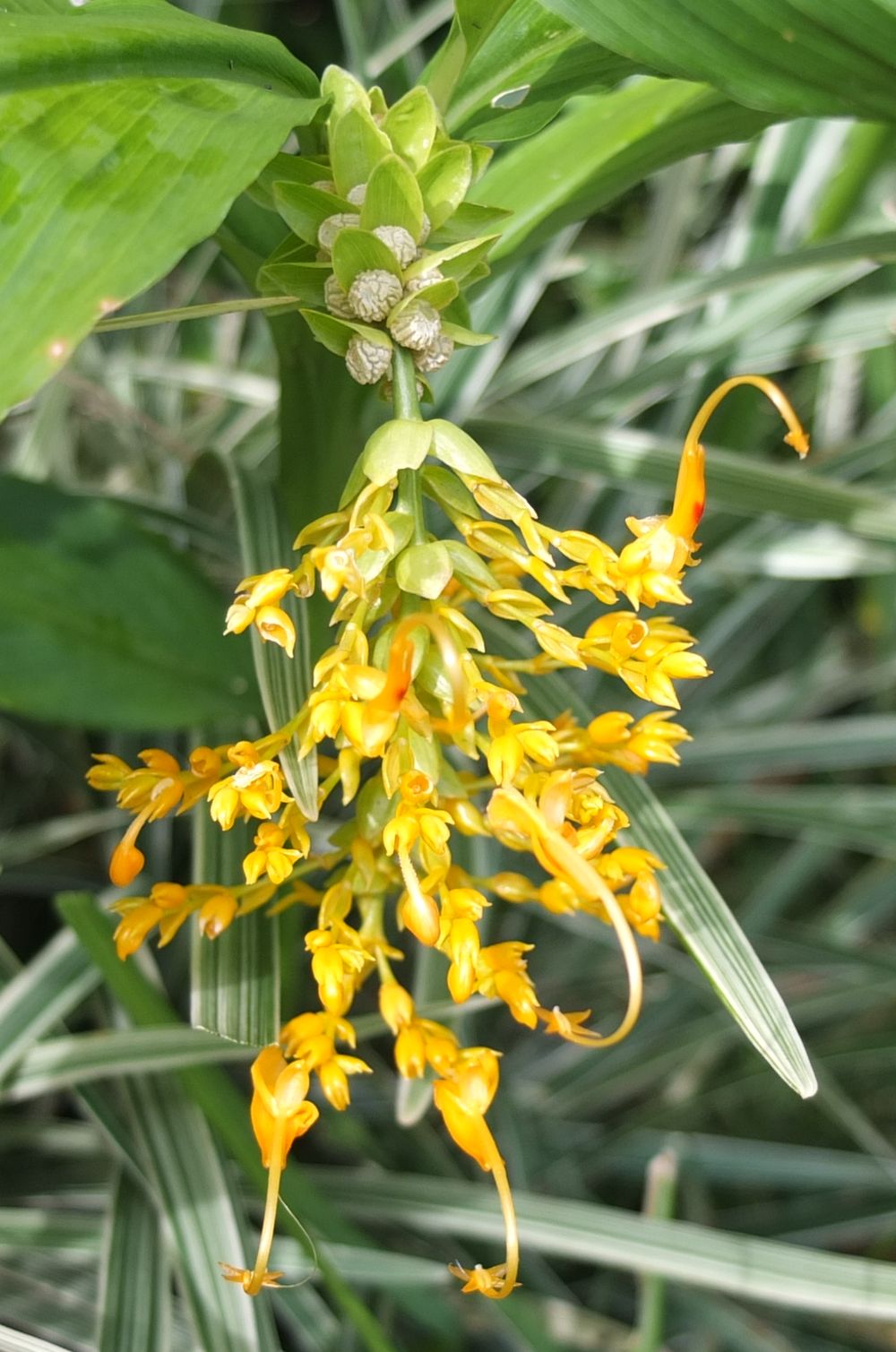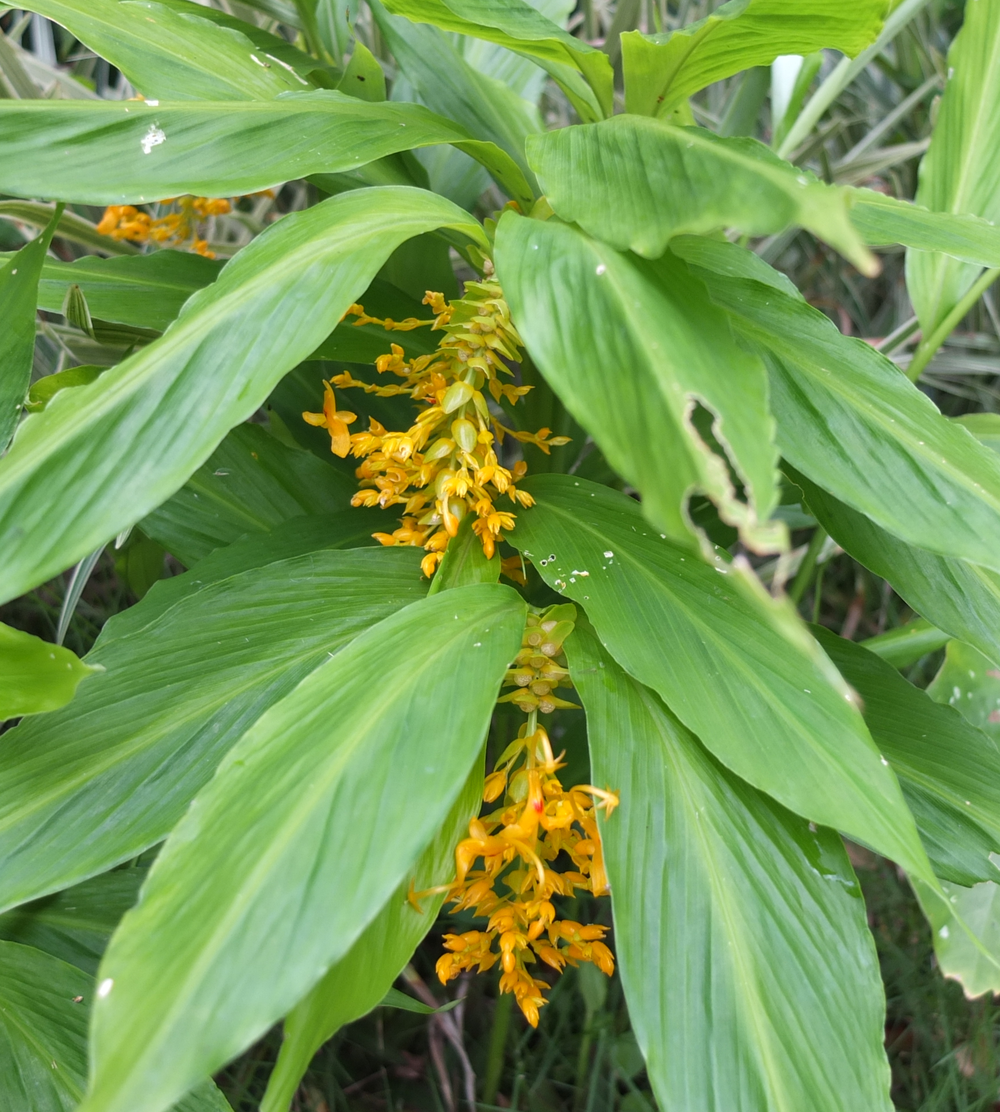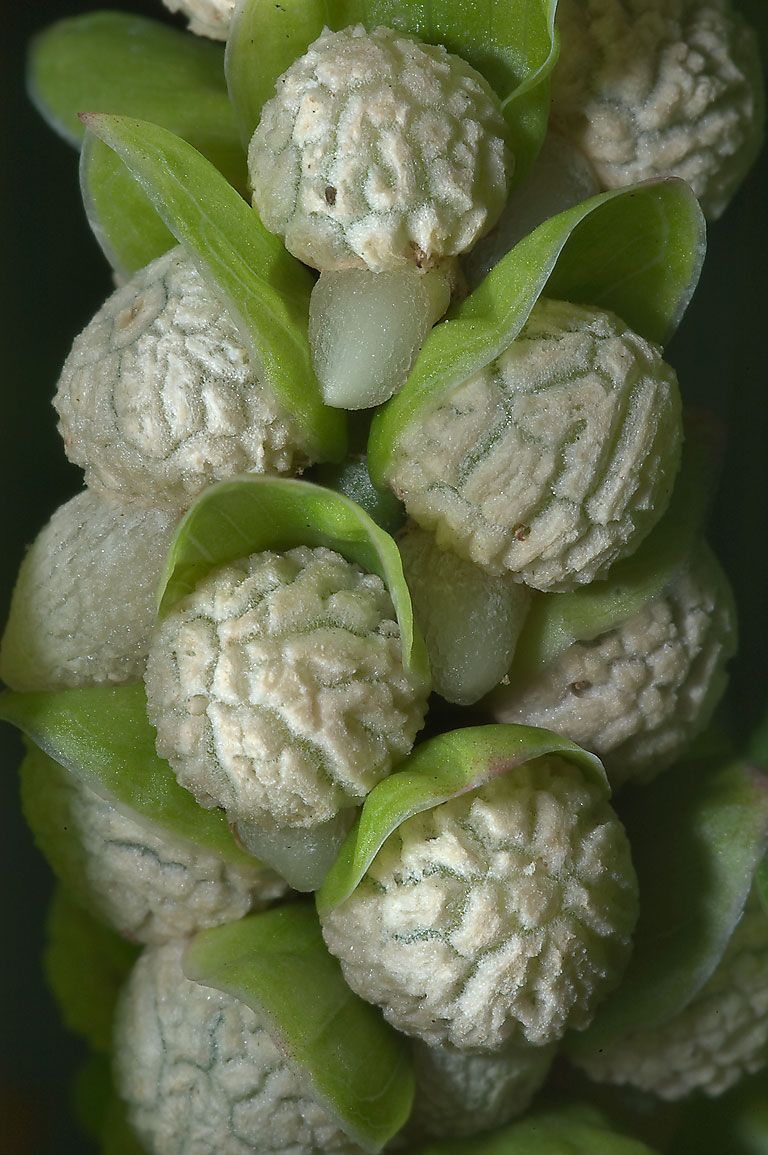The Indo-China peninsula is rich in Zingiberaceae, which are far from being completely explored. Botanists keep discovering new species, and, from time to time, these discoveries lead to revising the entire classification; it can be said that the taxonomy of this family is one of the most vague, that it is composed of numerous synonyms and, at the same time, important gaps. As of this writing, it consists of fifty-three genus (one thousand five hundred species), of which fifty are originally from South-east Asia and among them is the genre Globba.
Globba schomburgkii is a small plant, 60m tall, which grows in shade, in forests, in ravines up to an altitude of 1,000 metres. The largely oval leaves of about twenty cm, have pointed ends; they are glabrous, striated, and fluted. They form tufts at ground level, from which heavy clusters of light yellow flowers with indented tubular calyxes, and uneven petals with a labellum comprised of two triangular lobes. Another characteristic of this plant: the whitish, egg-shaped bulbils that appear on the inflorescence of the lower flowers. Thanks to these bulbils, the plant very easily reproduces. It is found in the forests of India, Burma, Indo-China, and Malaysia, but it can be cultivates in the shade in all tropical regions, where it blooms in the rainy season.
When choosing a name for this genre, Linne chose to reprise the Indonesian name of numerous zingiberaceae: “galona”, in Latin “globba”; the species is attributed to a German botanist, R. H. Schomburgk who picked it up/collected it in Thailand. The Lao call it neng nou, which means “cardamom mouse”, without doubt because of the small height of this plant, with leaves resembling those of the cardamom. As for the Thai, they use the term khamin phi, that is to say “turmeric of the spirits”; actually, one knows that of many numerous plants in the Zingiberaceae family, they are not only condiments but also medications considered to be powerful and magic plants.
Neng nou is no exception to this rule, because a decoction of its rhizomes has the reputation of lowering a fever, it is a “cold” medication, va dien; it is also considered as a cleanser for the blood, and it is applied to wounds.
La péninsule indochinoise est riche en Zingibéracées qui sont loin d’avoir été complètement explorées. Régulièrement les botanistes en découvrent de nouvelles et ces découvertes conduisent parfois à remanier toute la classification; on peut dire que la taxonomie de la famille est des plus floues, qu’elle comporte de nombreux synonymes et en même temps des lacunes importantes. Elle compte à l’heure actuelle cinquante-trois genres (mille cinq cents espèces), dont cinquante sont originaires d’Asie du Sud-Est et parmi eux le genre Globba.
Globba schomburgkii est une petite plante de 60 cm de haut qui se développe à l’ombre, en forêt, dans les ravines, jusqu’à 1000 mètres d’altitude. Les feuilles largement ovales, d’une vingtaine de centimètres, se terminent en pointe aigue; elles sont glabres, striées et cannelées. Elles forment des touffes au ras de terre d’où surgissent des grappes pendantes de légères fleurs jaunes au calice tubulaire denté, aux pétales irréguliers avec un labelle développé en deux lobes triangulaires. Autre caractéristique de cette plante, les bulbilles blanchâtres en forme d’œuf qui apparaissent sur l’inflorescence à la place des fleurs inférieures. Grâce à ces bulbilles la plante se reproduit très facilement. On la trouve dans les forêts d’Inde, de Birmanie, d’Indochine et de Malaisie, mais elle peut être cultivée à l’ombre dans toutes les régions tropicales où elle fleurit à la saison des pluies.
Linné a choisi, pour nommer ce genre, de reprendre le nom indonésien de plusieurs zingibéracées: « galoba » qui donne en latin « globba » ; l’espèce est attribuée à un botaniste allemand R.H. Schomburgk qui l’a ramassée en Thaïlande. Les Lao disent nèng nou, c’est-à-dire « cardamome souris » sans doute par allusion à la petite taille de cette plante dont les feuilles ressemblent à celles de la cardamome. Quant aux Thaï ils emploient le terme khamin phi, c’est à dire “curcuma des esprits”; on sait en effet que de très nombreuses plantes de la famille des Zingibéracées sont, non seulement des condiments, mais aussi des médicaments considérés comme puissants, et des plantes magiques.
Nèng nou ne fait pas exception à cette règle car ses rhizomes en décoction ont la réputation de faire tomber la fièvre, c’est un médicament « froid », ya dièn; il est aussi considéré comme « nettoyant » pour le sang et il est appliqué sur les blessures.



The Indo-China peninsula is rich in Zingiberaceae, which are far from being completely explored. Botanists keep discovering new species, and, from time to time, these discoveries lead to revising the entire classification; it can be said that the taxonomy of this family is one of the most vague, that it is composed of numerous synonyms and, at the same time, important gaps. As of this writing, it consists of fifty-three genus (one thousand five hundred species), of which fifty are originally from South-east Asia and among them is the genre Globba.
Globba schomburgkii is a small plant, 60m tall, which grows in shade, in forests, in ravines up to an altitude of 1,000 metres. The largely oval leaves of about twenty cm, have pointed ends; they are glabrous, striated, and fluted. They form tufts at ground level, from which heavy clusters of light yellow flowers with indented tubular calyxes, and uneven petals with a labellum comprised of two triangular lobes. Another characteristic of this plant: the whitish, egg-shaped bulbils that appear on the inflorescence of the lower flowers. Thanks to these bulbils, the plant very easily reproduces. It is found in the forests of India, Burma, Indo-China, and Malaysia, but it can be cultivates in the shade in all tropical regions, where it blooms in the rainy season.
When choosing a name for this genre, Linne chose to reprise the Indonesian name of numerous zingiberaceae: “galona”, in Latin “globba”; the species is attributed to a German botanist, R. H. Schomburgk who picked it up/collected it in Thailand. The Lao call it neng nou, which means “cardamom mouse”, without doubt because of the small height of this plant, with leaves resembling those of the cardamom. As for the Thai, they use the term khamin phi, that is to say “turmeric of the spirits”; actually, one knows that of many numerous plants in the Zingiberaceae family, they are not only condiments but also medications considered to be powerful and magic plants.
Neng nou is no exception to this rule, because a decoction of its rhizomes has the reputation of lowering a fever, it is a “cold” medication, va dien; it is also considered as a cleanser for the blood, and it is applied to wounds.
La péninsule indochinoise est riche en Zingibéracées qui sont loin d’avoir été complètement explorées. Régulièrement les botanistes en découvrent de nouvelles et ces découvertes conduisent parfois à remanier toute la classification; on peut dire que la taxonomie de la famille est des plus floues, qu’elle comporte de nombreux synonymes et en même temps des lacunes importantes. Elle compte à l’heure actuelle cinquante-trois genres (mille cinq cents espèces), dont cinquante sont originaires d’Asie du Sud-Est et parmi eux le genre Globba.
Globba schomburgkii est une petite plante de 60 cm de haut qui se développe à l’ombre, en forêt, dans les ravines, jusqu’à 1000 mètres d’altitude. Les feuilles largement ovales, d’une vingtaine de centimètres, se terminent en pointe aigue; elles sont glabres, striées et cannelées. Elles forment des touffes au ras de terre d’où surgissent des grappes pendantes de légères fleurs jaunes au calice tubulaire denté, aux pétales irréguliers avec un labelle développé en deux lobes triangulaires. Autre caractéristique de cette plante, les bulbilles blanchâtres en forme d’œuf qui apparaissent sur l’inflorescence à la place des fleurs inférieures. Grâce à ces bulbilles la plante se reproduit très facilement. On la trouve dans les forêts d’Inde, de Birmanie, d’Indochine et de Malaisie, mais elle peut être cultivée à l’ombre dans toutes les régions tropicales où elle fleurit à la saison des pluies.
Linné a choisi, pour nommer ce genre, de reprendre le nom indonésien de plusieurs zingibéracées: « galoba » qui donne en latin « globba » ; l’espèce est attribuée à un botaniste allemand R.H. Schomburgk qui l’a ramassée en Thaïlande. Les Lao disent nèng nou, c’est-à-dire « cardamome souris » sans doute par allusion à la petite taille de cette plante dont les feuilles ressemblent à celles de la cardamome. Quant aux Thaï ils emploient le terme khamin phi, c’est à dire “curcuma des esprits”; on sait en effet que de très nombreuses plantes de la famille des Zingibéracées sont, non seulement des condiments, mais aussi des médicaments considérés comme puissants, et des plantes magiques.
Nèng nou ne fait pas exception à cette règle car ses rhizomes en décoction ont la réputation de faire tomber la fièvre, c’est un médicament « froid », ya dièn; il est aussi considéré comme « nettoyant » pour le sang et il est appliqué sur les blessures.






The Indo-China peninsula is rich in Zingiberaceae, which are far from being completely explored. Botanists keep discovering new species, and, from time to time, these discoveries lead to revising the entire classification; it can be said that the taxonomy of this family is one of the most vague, that it is composed of numerous synonyms and, at the same time, important gaps. As of this writing, it consists of fifty-three genus (one thousand five hundred species), of which fifty are originally from South-east Asia and among them is the genre Globba.
Globba schomburgkii is a small plant, 60m tall, which grows in shade, in forests, in ravines up to an altitude of 1,000 metres. The largely oval leaves of about twenty cm, have pointed ends; they are glabrous, striated, and fluted. They form tufts at ground level, from which heavy clusters of light yellow flowers with indented tubular calyxes, and uneven petals with a labellum comprised of two triangular lobes. Another characteristic of this plant: the whitish, egg-shaped bulbils that appear on the inflorescence of the lower flowers. Thanks to these bulbils, the plant very easily reproduces. It is found in the forests of India, Burma, Indo-China, and Malaysia, but it can be cultivates in the shade in all tropical regions, where it blooms in the rainy season.
When choosing a name for this genre, Linne chose to reprise the Indonesian name of numerous zingiberaceae: “galona”, in Latin “globba”; the species is attributed to a German botanist, R. H. Schomburgk who picked it up/collected it in Thailand. The Lao call it neng nou, which means “cardamom mouse”, without doubt because of the small height of this plant, with leaves resembling those of the cardamom. As for the Thai, they use the term khamin phi, that is to say “turmeric of the spirits”; actually, one knows that of many numerous plants in the Zingiberaceae family, they are not only condiments but also medications considered to be powerful and magic plants.
Neng nou is no exception to this rule, because a decoction of its rhizomes has the reputation of lowering a fever, it is a “cold” medication, va dien; it is also considered as a cleanser for the blood, and it is applied to wounds.
La péninsule indochinoise est riche en Zingibéracées qui sont loin d’avoir été complètement explorées. Régulièrement les botanistes en découvrent de nouvelles et ces découvertes conduisent parfois à remanier toute la classification; on peut dire que la taxonomie de la famille est des plus floues, qu’elle comporte de nombreux synonymes et en même temps des lacunes importantes. Elle compte à l’heure actuelle cinquante-trois genres (mille cinq cents espèces), dont cinquante sont originaires d’Asie du Sud-Est et parmi eux le genre Globba.
Globba schomburgkii est une petite plante de 60 cm de haut qui se développe à l’ombre, en forêt, dans les ravines, jusqu’à 1000 mètres d’altitude. Les feuilles largement ovales, d’une vingtaine de centimètres, se terminent en pointe aigue; elles sont glabres, striées et cannelées. Elles forment des touffes au ras de terre d’où surgissent des grappes pendantes de légères fleurs jaunes au calice tubulaire denté, aux pétales irréguliers avec un labelle développé en deux lobes triangulaires. Autre caractéristique de cette plante, les bulbilles blanchâtres en forme d’œuf qui apparaissent sur l’inflorescence à la place des fleurs inférieures. Grâce à ces bulbilles la plante se reproduit très facilement. On la trouve dans les forêts d’Inde, de Birmanie, d’Indochine et de Malaisie, mais elle peut être cultivée à l’ombre dans toutes les régions tropicales où elle fleurit à la saison des pluies.
Linné a choisi, pour nommer ce genre, de reprendre le nom indonésien de plusieurs zingibéracées: « galoba » qui donne en latin « globba » ; l’espèce est attribuée à un botaniste allemand R.H. Schomburgk qui l’a ramassée en Thaïlande. Les Lao disent nèng nou, c’est-à-dire « cardamome souris » sans doute par allusion à la petite taille de cette plante dont les feuilles ressemblent à celles de la cardamome. Quant aux Thaï ils emploient le terme khamin phi, c’est à dire “curcuma des esprits”; on sait en effet que de très nombreuses plantes de la famille des Zingibéracées sont, non seulement des condiments, mais aussi des médicaments considérés comme puissants, et des plantes magiques.
Nèng nou ne fait pas exception à cette règle car ses rhizomes en décoction ont la réputation de faire tomber la fièvre, c’est un médicament « froid », ya dièn; il est aussi considéré comme « nettoyant » pour le sang et il est appliqué sur les blessures.


